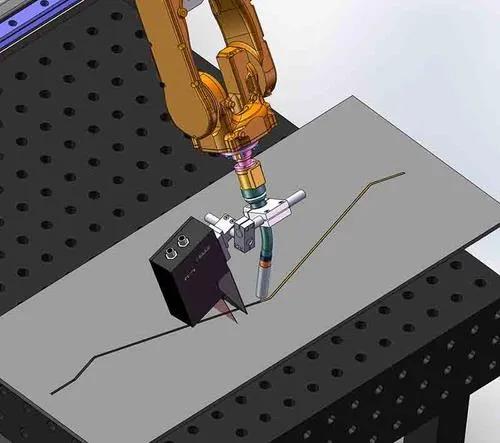All you need know about the latest application of laser welding robot
Since the robot was invented, welding has been the first application of industrial robots. According to the International Federation of Robotics, 50% of the world's robots are used for welding. Using six-axis robots, assemblers can weld parts better, faster, more consistently, and more safely.
The capabilities of welding robots have been greatly improved in recent years, and they have become easier to use and cheaper to deploy. The technology that once belonged only to automobile equipment manufacturers and other large manufacturers is now in the application range of small and medium enterprises.
Driven by the needs of the automotive industry, laser welding is one of the fastest growing applications of six-axis robots. Different from the traditional spot welding process, laser welding robot can achieve molecular bonding between two steel plates, which greatly improves the bonding accuracy of the car body.
In addition, laser welding has the characteristics of extremely small deformation of the workpiece to be welded, almost no connection gap, and high welding depth/width ratio, so the welding quality is higher than that of traditional welding methods. Through electronic computer processing, according to different welding objects and requirements, projects such as welding seam tracking, defect detection, welding seam quality monitoring, etc. are realized, and welding process parameters are adjusted through feedback control to realize automatic laser welding. Therefore, it can well solve the pressure of automobile manufacturers to reduce the weight of vehicles and improve the accuracy and strength of the body.

Principles of laser welding robot processing
Laser welding robot processing is a processing method in which a focused laser beam is used as a heat source to bombard the workpiece to melt metal or non-metal workpieces to form small holes, cuts, connections, cladding, etc. Laser processing is essentially a process in which lasers interact with non-transparent materials. It is a quantum process in the microscopic view, and manifested as reflection, absorption, heating, melting, and vaporization in the macroscopic view.
Under the laser beam of different power density, the surface area of the material undergoes various changes, these changes include surface temperature increase, melting, vaporization, formation of small holes, and the generation of photo-induced plasma.
1 Laser power density is less than orders of magnitude
When the laser power density is less than an order of magnitude, the absorption of laser energy by the metal will only cause the surface temperature of the material to rise, but the solid phase will remain unchanged. It is mainly used for surface heat treatment, phase change hardening treatment or brazing of parts. When the laser power density is within the order of magnitude, heat conduction heating will occur, and the surface of the material will melt. It is mainly used for metal surface remelting, alloying, cladding and heat conduction welding (such as thin plate high-speed welding and precision spot welding, etc.).
2 Laser power density reaches the order of magnitude
When the laser power density reaches the order of magnitude, the surface of the material is irradiated by the laser beam, and the heating temperature of the laser heat source reaches the boiling point of the metal, forming a plasma vapor and violently vaporizing. Under the pressure of vaporization expansion, the liquid surface dents downward to form a deep melted small holes; at the same time, the metal vapor is ionized under the action of the laser beam to produce photo-induced plasma. This stage is mainly used for laser beam deep penetration welding, cutting and drilling.
3 Laser beam power density is greater than orders of magnitude
When the power density of the laser beam is greater than the order of magnitude, the photo-induced plasma will propagate against the incident direction of the laser beam, forming a plasma cloud, and the phenomenon of shielding the laser by the plasma will occur. This stage is only suitable for drilling with pulsed lasers, impact hardening and other processing.

The latest laser welding robot processing technology is here
With the continuous development of laser technology, laser processing equipment of several kilowatts is competing to appear, and combined with photoelectric tracking, computer digital control, industrial welding robots and other technologies, the automation level and use functions of laser processing have been greatly improved. If you have any question about laser welding robot, feel free to submit to us, we will send product catalog for you to review.